The most effective light wavelengths for ATP energy production focus on red and near-infrared ranges. You'll get peak benefits from 660nm for surface-level cellular activation, 670nm for morning glucose regulation, and 830nm for deep tissue penetration. Combined wavelengths like 635nm/810nm work synergistically to boost ATP at multiple tissue depths. Other powerful options include 850nm for mitochondrial activation and the 630-670nm red light range. For ideal results, you'll want to use power densities between 20-100 mW/cm² and consider dual protocols like 660nm-830nm. The science behind these specific wavelengths reveals fascinating cellular mechanisms that transform light into cellular energy.
Understanding 660nm Light Benefits
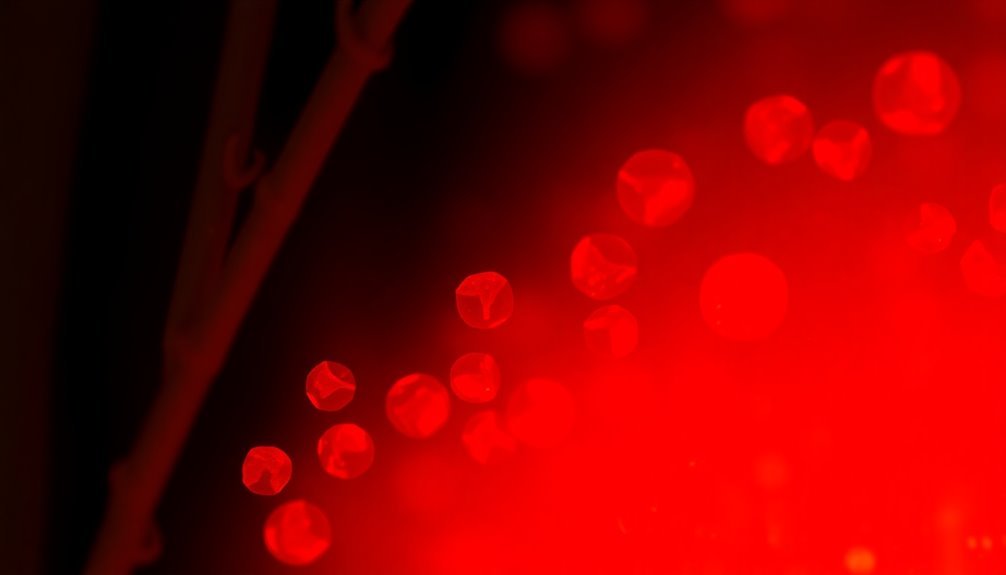
Deep within our cells, 660nm red light works through a remarkable mechanism to boost energy production. When this specific wavelength penetrates your tissue, it activates cytochrome C oxidase in your mitochondria, triggering increased ATP production – your body's primary energy source. This enhanced cellular energy production directly supports cell regeneration and healing processes.
You'll find that 660nm light improves your mitochondrial efficiency by helping break down nitric oxide and generating more ATP. This boost in energy metabolism can reduce your fatigue levels and enhance muscle performance. The light also stimulates fibroblast activity, which is essential for wound healing and tissue repair. The intensity of benefits gradually decreases as light penetrates 1 to 50 millimeters deeper into tissue.
What makes 660nm light particularly effective is its ability to trigger beneficial reactions in your cellular structures. It activates photoreceptor proteins, enhancing mitochondrial respiration while stimulating EZ water formation and ROS signaling.
These mechanisms support your overall cellular health and function. Clinical studies have consistently shown that this wavelength improves wound healing, reduces inflammation, and promotes tissue repair.
If you're looking to enhance your body's energy production and cellular function, 660nm red light therapy offers a scientifically-backed approach that works at the molecular level.
Deep Tissue Effects at 830nm
While 660nm red light excels at surface-level cellular activation, the unique properties of 830nm near-infrared light allow it to reach much deeper into your body's tissues. This wavelength can penetrate up to 2mm before losing just 37% of its intensity, making it ideal for treating muscle and joint conditions that lie beneath your skin's surface.
When you're dealing with deep tissue issues, 830nm light therapy offers several significant benefits:
- Reduces delayed-onset muscle soreness (DOMS) by increasing your pressure pain threshold, helping you recover faster from intense workouts.
- Stimulates cellular function through photobiomodulation, promoting ATP energy production and healing at the deepest tissue levels.
- Enhances your joint range of motion after exercise, making it particularly effective for athletic recovery.
For optimal research tracking, users can follow journal updates to stay informed about the latest developments in light therapy applications.
For best results, you'll want to use 830nm therapy at 315 J/cm2 with an output power of 210mW. The most effective approach is applying the light for 10 minutes at 10 Hz frequency across six sites in the affected muscle area.
Whether you choose continuous or pulsed wave delivery, you'll benefit from the deep-penetrating properties that make 830nm light especially effective for muscle recovery and pain management.
Optimal 670nm Cellular Response
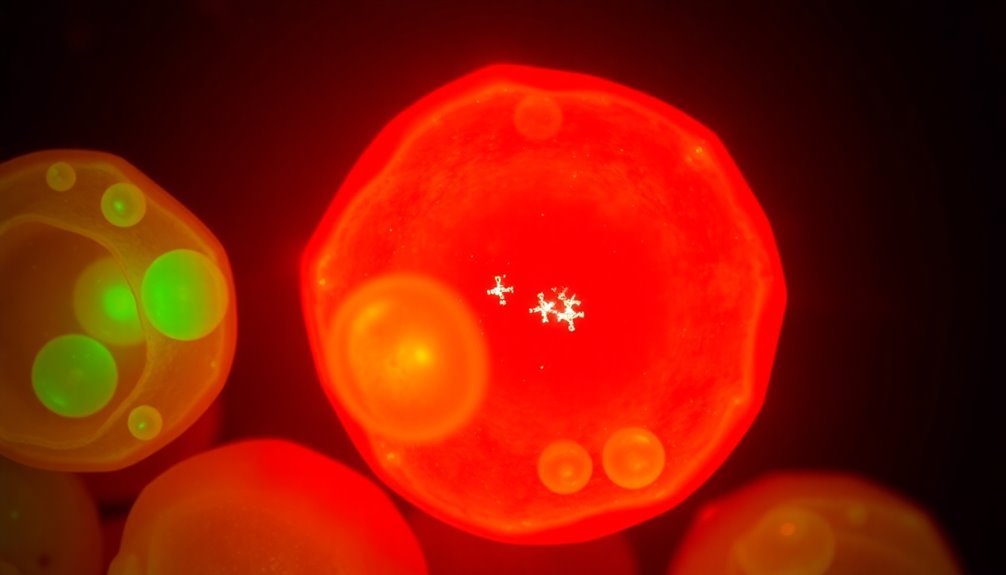
Research reveals that 670nm light therapy achieves its peak effectiveness during morning hours when your cells are most receptive to ATP production. Studies show significant ATP increases specifically at 8:00 AM, while exposure at other times yields less impressive results.
Your mitochondrial respiration follows a natural circadian rhythm, making timing essential for ideal benefits. A recent study demonstrated that just fifteen minutes of exposure can reduce blood glucose levels by 27.7%.
When you expose your cells to 670nm light, you'll trigger multiple beneficial responses. The light stimulates your mitochondria to produce more energy, improving glucose consumption and enhancing membrane potential.
You'll experience reduced inflammation as the therapy activates specific cellular pathways and improves your body's redox state. Just one minute of exposure can boost your ATP production within an hour and maintain improved respiration for nearly a week.
You'll find that 670nm light therapy offers wide-ranging benefits beyond local effects. It can help manage diabetes by reducing blood glucose levels, protect your neurons from damage, and improve retinal function.
The therapy's non-invasive nature makes it an attractive alternative to traditional treatments, especially when you're dealing with age-related conditions or metabolic issues.
Near-Infrared 810nm Power
Near-infrared light at 810nm reaches deeper into your tissues than visible red light, making it particularly effective for treating muscle and bone conditions.
You'll find that 810nm light considerably boosts ATP production through its interaction with mitochondrial complex-IV, especially when applied in pulsed mode at 1W/cm² power density.
Research shows this wavelength can increase cellular energy production by up to 0.2%, with ideal results achieved using specific parameters like 60J/cm² fluence and 10Hz frequency.
Studies demonstrate that non-destructive intensities are crucial for optimal therapeutic outcomes, with power levels remaining below several kW/m² to maintain safe and effective treatment conditions.
Deep Tissue Penetration Benefits
Understanding how 810nm light penetrates deep tissue reveals its remarkable therapeutic potential. When using 810nm near-infrared light, you'll benefit from its ability to reach 3-4 cm into your body, even penetrating through the skull to support neuronal repair and cognitive function. This wavelength's exceptional penetration depth makes it particularly effective for treating deep-seated conditions and promoting cellular health. ATP production increases substantially when cells are exposed to 810nm wavelengths.
- You'll experience enhanced bone repair and growth, making it valuable for fractures and osteoporosis treatment, while also benefiting from improved calcium distribution within your cells.
- Your chronic pain and inflammation can greatly reduced as the light reaches deep tissues and nerves, effectively treating conditions like arthritis.
- You'll see better results with neurological conditions, as 810nm light can penetrate the skull and support brain healing.
The effectiveness of 810nm light depends on proper delivery methods. You'll achieve best results using pulsed light rather than continuous waves, and higher intensities (around 100mW/cm²) are necessary for reaching tissues deeper than 50mm.
When properly applied, this wavelength outperforms both shorter (600-700nm) and longer (980-1064nm) wavelengths for deep tissue treatment.
ATP Production Research Results
Recent studies on 810nm near-infrared light reveal compelling evidence for ideal ATP production through specific power thresholds and timing.
Research shows that you'll achieve prime results with power levels between 0.8-1.1W, while lower powers around 0.1W can actually inhibit ATP synthesis and potentially cause oxidative stress.
When using 810nm light, you can expect increased mitochondrial energy output for approximately 2 minutes when applying either 0.5W for 30 seconds or 1W for 60 seconds. Studies have shown that applying complex IV absorption occurs most effectively within this wavelength range.
You'll want to time your exposure strategically, as ATP production follows a natural circadian rhythm with peak effectiveness in the morning hours. The research indicates significant ATP increases at 8:00 and 11:00, with production declining around midday.
The mechanism behind these results involves cytochrome c oxidase, which absorbs the infrared light and enhances electron transport chain efficiency.
This interaction improves oxygen utilization in your mitochondria and reduces harmful reactive oxygen species.
You'll find these effects are consistent across species, from flies to humans, demonstrating the universal nature of light's impact on cellular energy production.
The combination of correct wavelength, power, and timing is essential for achieving the desired ATP enhancement.
Combining 635nm and 810nm
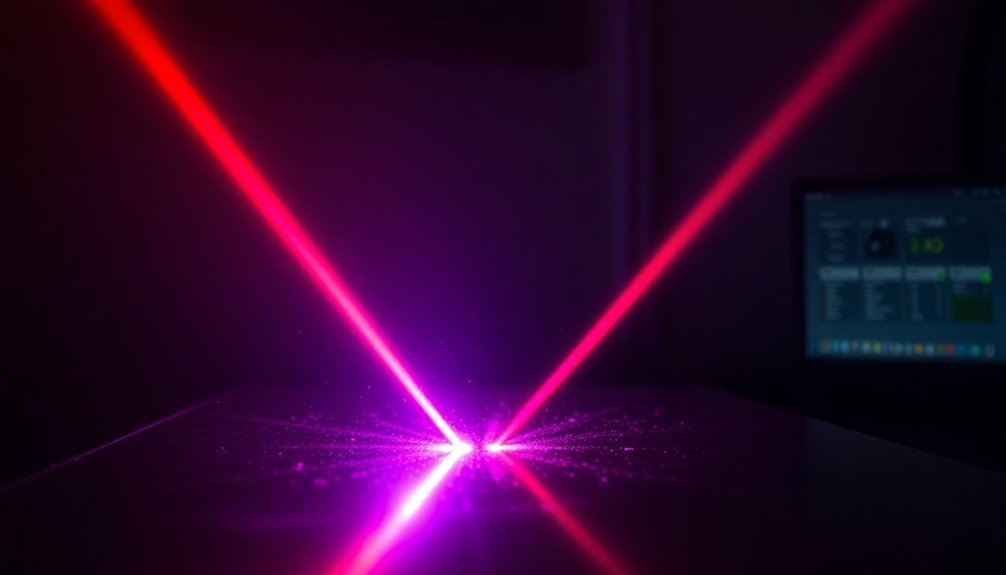
You'll get the most powerful healing effects when you combine 635nm red light with 810nm near-infrared light, as they work together to boost ATP production at different tissue depths.
While the 635nm wavelength effectively targets surface-level cells and superficial tissues, the 810nm wavelength penetrates deeper to reach muscles, joints, and internal organs. Research shows that longer NIR wavelengths allow significantly greater penetration into deeper tissues for enhanced therapeutic benefits.
Setting both wavelengths at clinically proven power densities (typically between 20-100 mW/cm²) guarantees you're getting ideal biological effects throughout the treatment area.
Synergistic Healing Effects
The synergistic combination of 635nm red light and 810nm near-infrared light creates a powerful healing effect that's greater than using either wavelength alone. When these wavelengths work together, they activate cytochrome c oxidase, boost ATP production, and enhance your body's natural repair mechanisms at multiple levels. Research shows clinical effectiveness appears in over 5,000 studies and 500 double-blind trials supporting these therapeutic benefits.
You'll experience enhanced healing through three primary mechanisms:
- Increased cellular energy production through stimulated mitochondrial activity and ATP synthesis
- Accelerated tissue repair due to enhanced collagen synthesis and fibroblast proliferation
- Reduced inflammation and improved blood flow through enhanced angiogenesis
This powerful combination penetrates different tissue depths, making it effective for various therapeutic applications. The 635nm wavelength works effectively on surface-level concerns like skin rejuvenation and superficial wounds, while 810nm reaches deeper to address muscle and joint issues.
You'll find this dual-wavelength approach particularly effective for complex conditions like diabetic wounds and burn injuries, where thorough healing is essential. The synergistic effects also help prevent excessive scarring by promoting proper collagen formation during the healing process, leading to better aesthetic outcomes.
Optimal Power Settings
While combining 635nm and 810nm wavelengths creates powerful synergistic effects, achieving ideal results depends heavily on proper power settings.
These wavelengths are specifically chosen for their optimal water absorption, making them highly effective for therapeutic treatments.
You'll need to balance power density and energy density carefully, as too little power won't deliver results, while excessive power can prove harmful or ineffective.
For optimal DNA synthesis, research suggests maintaining power density around 0.8 mW cm-2.
You can choose between pulsed and continuous light settings based on your treatment needs. Pulsed settings work better for delivering energy deeper into tissues without causing heat buildup, while continuous wave settings are ideal for lower-power surface treatments.
When using both 635nm and 810nm wavelengths together, you'll want to adjust settings based on your specific treatment goals.
Professional devices with adjustable power settings give you the most flexibility and control. You can fine-tune the intensity and duration for different body areas, as various tissues respond differently to each wavelength.
For full-body treatments, you'll benefit most from devices that let you customize both wavelengths and power settings independently, ensuring maximum energy delivery for ATP production across different tissue types.
Deep Tissue Penetration
Achieving ideal therapeutic benefits requires understanding how different wavelengths penetrate tissue depths. When you're using light therapy for ATP energy production, the combination of 635nm red light and 810nm near-infrared (NIR) light provides thorough coverage for both superficial and deep tissues.
While 635nm wavelengths effectively target surface-level cells and promote healing through cytochrome c oxidase activation, 810nm NIR light penetrates deeper to reach joints, muscles, and internal tissues. The absorption coefficient of water is notably higher at longer wavelengths above 1000nm, making 810nm an optimal choice for therapeutic applications.
For maximum therapeutic impact, you'll want to focus on these key penetration factors:
- The 810nm wavelength penetrates considerably deeper than red light, making it ideal for treating joint pain, muscle fatigue, and deep tissue inflammation.
- Combining 635nm and 810nm wavelengths guarantees you're targeting both superficial and deep tissue layers simultaneously.
- Near-infrared light experiences less scattering in biological tissues, allowing for more effective deep tissue treatment.
The synergistic effect of these wavelengths enhances overall tissue repair and healing.
You'll get better results using this dual-wavelength approach compared to single-wavelength treatments, as it activates healing mechanisms at various tissue depths while promoting ATP production throughout the treatment area.
Peak Performance at 780nm
Research has zeroed in on 780nm as a standout wavelength for ideal ATP energy production in cells. This wavelength effectively stimulates your mitochondria by interacting with cytochrome C oxidase in the respiratory chain, triggering increased ATP synthesis.
You'll find that 780nm light therapy works through multiple mechanisms to boost cellular energy production. When you're exposed to 780nm light, it enhances your mitochondrial membrane potential and activates essential calcium channels.
It'll also generate controlled amounts of reactive oxygen species (ROS), which play a significant role in cellular signaling pathways. You won't just see increased ATP production – you'll also experience improved cell proliferation and collagen synthesis in your fibroblasts.
The key to getting optimal results lies in proper dosing. You'll want to stay within specific fluence ranges, as too much exposure can actually inhibit cellular function.
Different cells in your body will respond uniquely to 780nm light, which is why treatment protocols need careful calibration. When used correctly, you'll benefit from enhanced muscle regeneration, improved wound healing, and better overall cellular metabolism.
Red Light Range 630-670nm
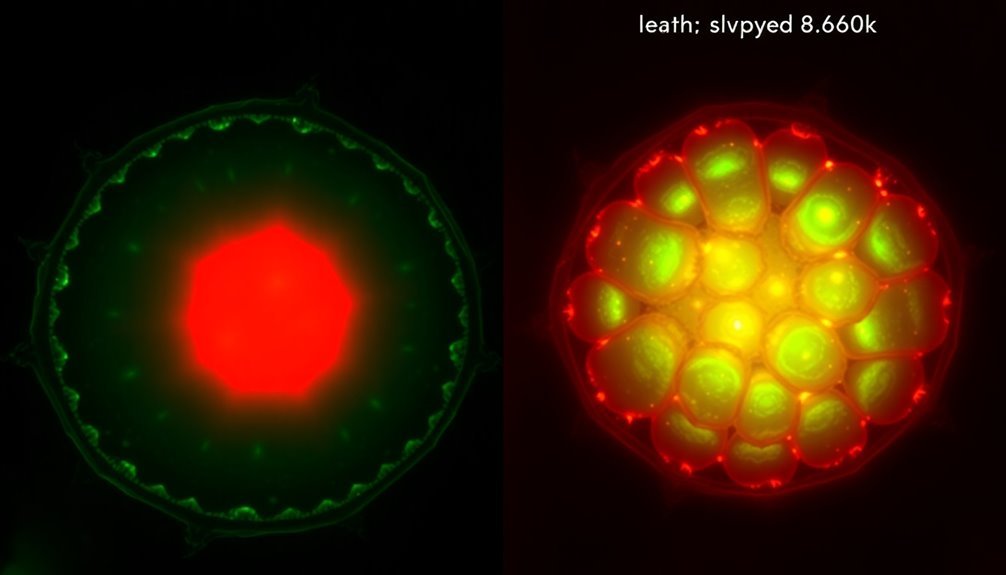
The red light range of 630-670nm stands as another powerful spectrum for ATP energy production, complementing the benefits seen at 780nm. This wavelength range specifically targets cytochrome c oxidase, a key enzyme in your cells' mitochondria, triggering enhanced ATP synthesis and boosting your cellular energy levels.
Through photobiomodulation, this specific red light spectrum activates your mitochondria and promotes nitric oxide release, leading to improved circulation and reduced inflammation.
You'll experience several key benefits when using red light therapy in the 630-670nm range:
- Increased ATP production and cellular energy, which directly enhances your muscle performance and speeds up recovery after physical activity.
- Improved skin health through enhanced collagen synthesis and tissue repair, supported by the boost in ATP production.
- Strengthened immune system function via increased lymphocyte proliferation and modulated immune responses.
Clinical studies, including NASA-led research, have consistently demonstrated these therapeutic effects. The biological pathways are well-documented, showing how this wavelength range stimulates your cells' energy production mechanisms.
When you're looking to optimize your cellular energy production, the 630-670nm range offers scientifically proven benefits for overall health and performance.
NIR Spectrum 810-890nm
You'll find that near-infrared (NIR) light in the 810-890nm range penetrates deeper into your tissues than red light, effectively reaching cells and structures that lie further beneath your skin's surface.
This wavelength range is particularly effective at stimulating cytochrome c oxidase in your mitochondria, leading to ideal ATP energy production in deeper tissues like muscles and bones.
The enhanced penetration depth combined with peak mitochondrial activation makes this spectrum especially valuable for treating deep tissue conditions and boosting cellular energy in structures that red light can't effectively reach.
Deep Tissue Penetration Benefits
Near-infrared (NIR) light between 810-890nm stands out as the most effective wavelength range for reaching deep tissue structures in the body. Research shows that NIR penetrates 42% deeper than red light (630-670nm), making it particularly effective for treating conditions that affect muscles, joints, and deeper tissues.
You'll find that NIR's superior penetration directly impacts its ability to reduce inflammation and promote healing in areas that other wavelengths can't effectively reach.
When you're looking to maximize the benefits of NIR therapy, these key advantages make it particularly valuable:
- Joint pain relief and improved mobility through deep-tissue inflammation reduction
- Enhanced wound healing capabilities, especially for chronic and diabetic wounds
- Significant neurological benefits, including improved outcomes in traumatic brain injury cases
The clinical evidence supporting NIR therapy is substantial, particularly at wavelengths of 810nm and 830nm.
You'll see the most dramatic results when targeting deep tissue conditions, as NIR effectively activates cytochrome c oxidase in cells far below the skin's surface. This activation triggers cellular repair and regeneration, making NIR therapy an invaluable tool for treating deep-seated inflammation and promoting tissue healing.
Optimal Mitochondrial Stimulation Range
Within the NIR spectrum, wavelengths around 810 nm emerge as particularly potent for mitochondrial stimulation and ATP production. You'll find this specific wavelength directly interacts with cytochrome c oxidase (CCO), an essential enzyme in your cellular energy production chain.
When your cells absorb these NIR photons, they trigger a series of beneficial reactions that boost ATP synthesis and restore mitochondrial function.
You'll get the best results when you use 810 nm light at a 10 Hz frequency, rather than continuous wave or 100 Hz applications. This pulsing rate has shown superior outcomes in promoting wound healing and optimizing mitochondrial performance.
The mechanism works by photodissociating nitric oxide from CCO, which removes a natural inhibitor of energy production in your mitochondria.
What makes this wavelength particularly effective is its ability to enhance oxidative phosphorylation while reducing oxidative stress. You're not just getting increased energy production; you're also benefiting from improved cellular metabolism and reduced inflammation.
This combination makes 810 nm light therapy particularly promising for treating conditions linked to mitochondrial dysfunction, from athletic recovery to neurological conditions.
Mitochondrial Activation Using 850nm
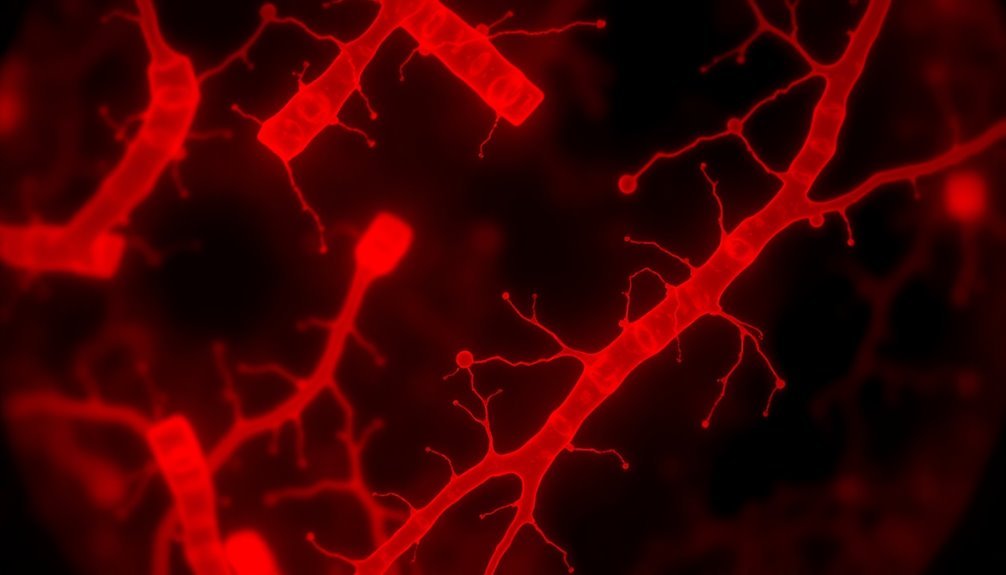
Through extensive research, scientists have identified 850nm as a powerful wavelength for mitochondrial activation, with studies showing it produces the highest increases in cell respiration when applied continuously.
You'll find this wavelength particularly effective at stimulating the electron transport system and cytochrome c oxidase activity at the mitochondrial complex level.
When you're considering light therapy for ATP production, 850nm offers several distinct advantages:
- It penetrates deep into tissues, promoting cellular regeneration and reducing chronic pain.
- It's more affordable and widely available due to its common use in security cameras.
- It effectively stimulates mitochondrial function similar to 800nm lasers while being more cost-effective.
However, you should be aware that 850nm does have some limitations compared to other wavelengths.
While it's excellent for general mitochondrial activation, it's not as effective as 808nm for treating deep tissues like tendons and joints.
You'll also need longer treatment times with LED-based 850nm devices compared to lasers, as they typically have lower irradiance levels.
Despite these constraints, 850nm remains a practical choice for enhancing cellular energy production and optimizing muscle performance.
Dual Wavelength 660nm-830nm Protocol
Combining the therapeutic powers of 660nm and 830nm wavelengths creates a synergistic effect that maximizes ATP production and cellular regeneration. While 660nm wavelengths excel at boosting ATP production and maintaining longer-lasting cellular responses, 830nm requires less energy for initial cell stimulation, making them complementary partners in light therapy protocols.
You'll find this dual-wavelength approach particularly effective for muscle recovery and performance enhancement. The 660nm wavelength penetrates deeply into tissue and directly stimulates mitochondrial respiration, while 830nm excels at reducing inflammation and edema. When you're targeting multiple therapeutic outcomes, this combination proves invaluable.
For ideal results, you'll want to take into account the specific needs of different tissues. The 660nm wavelength works exceptionally well for bone healing, hair growth, and chronic skin conditions, while 830nm shines in acute inflammatory processes.
Together, they enhance collagen and elastin production, improve muscle healing, and reduce fatigue more effectively than either wavelength alone. You can expect extensive benefits across various biological processes, from pain management to tissue regeneration, making this dual-wavelength protocol a powerful therapeutic tool.
Frequently Asked Questions
Can Multiple Light Therapy Sessions in One Day Increase ATP Production?
You can boost ATP production with multiple daily sessions, but you'll need proper spacing between treatments. Don't overdo it – excessive exposure may cause oxidative stress and actually inhibit ATP synthesis.
How Does Ambient Room Lighting Affect Red Light Therapy Effectiveness?
Ambient lighting can reduce your red light therapy's effectiveness by diluting its intensity and introducing competing wavelengths. You'll get better results by using it in a dimly lit or dark room to minimize interference.
Does Skin Pigmentation Change the Optimal Wavelength for ATP Production?
While your skin pigmentation affects light absorption, ideal wavelengths (630-670nm and 810-890nm) remain effective for ATP production across all skin types. You'll get best results using near-infrared wavelengths that penetrate deeper.
Are There Specific Foods That Enhance Light Therapy's ATP Production Effects?
You'll boost light therapy's ATP effects by eating foods rich in beta-carotene, CoQ10, and omega-3s. Include sweet potatoes, fatty fish, nuts, and berries. Avoid high-sugar foods and processed fats that inhibit mitochondrial function.
Does Age Impact the Body's Response to Light Therapy for ATP Production?
Yes, as you age, your body's response to light therapy for ATP production diminishes. You'll experience reduced mitochondrial efficiency and cellular function, requiring more precise treatment settings to achieve ideal ATP-boosting results.
In Summary
You'll get the best ATP production results by combining specific red and near-infrared wavelengths in your light therapy. Focus on the 660nm/830nm dual protocol for ideal cellular response, or try pairing 635nm with 810nm. These wavelength combinations penetrate effectively to stimulate your mitochondria. Whether you're using LED panels or targeted devices, stick to the proven ranges of 630-670nm for red light and 810-890nm for NIR.





Leave a Reply